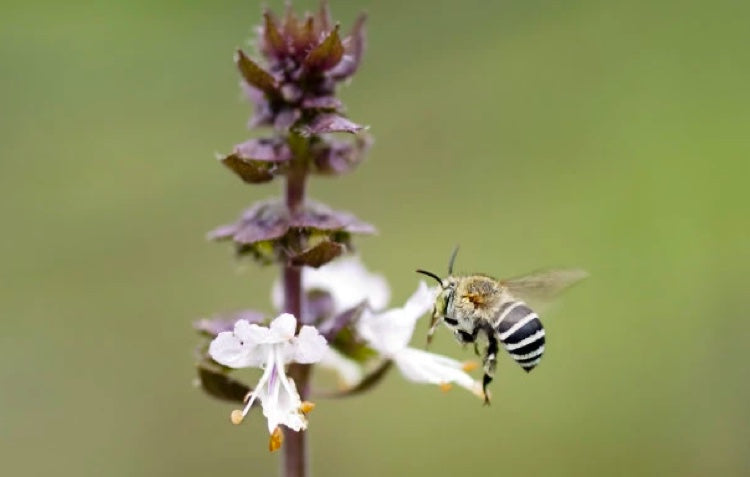Whether you have a large garden, modest courtyard or simple window box, you can make a few small changes that will offer big benefits to our most important pollinators. Honey bees are responsible for pollinating a wealth of plants, fruits, vegetables and other crops that not only feed us but our livestock too, with up to a third of all food consumed relying on pollination by bees, alongside other insects, birds and bats. Sadly bees are in decline for reasons including threatened habitats, loss of land and increased pesticide use.
There are over 1,500 species of native bees found in Australia and, thanks to their laborious work ethic, they are some of the most important creatures on Earth, well worth looking after. Creating a bee-friendly haven is both easy and rewarding, so why not give it a go?
Flower power

The plants you have growing in your garden play a big role in which insects will visit. Beautiful brightly coloured blooms act as a magnet for our native bees, and a small smattering of flowers amongst your veggie patch will ensure a fruitful crop too. Lavender is a firm favourite in the insect world and, thanks to its long flowering period, you can welcome bees into your garden all year round with a couple of these fragrant purple plants. Lavender has long been used for its aromatic and healing properties, and for the huge diversity of insects its nectar attracts. It also grows well in pots, making it the ideal plant for balconies and small courtyards.
If you want to get the kids or grandkids involved, why not sow a sunflower patch? Easy to grow, striking to look at and beneficial to both bees and birds, a good old-fashioned sunflower ticks all the boxes. Another plant with multiple benefits is the nasturtium. These bee-friendly flowers grow readily from seed and can be eaten in bloom too – delicious when sprinkled over a salad!
Some bees prefer to forage only on native flowers, such as the 'Bottlebrush' Callistemon. These stunning bristle-like flowers are easy to care for and can tolerate most soil types and a sunny garden; attracting bees, birds, skinks and other small animals who like to take shelter in the striking shrub.
A mix of both native and exotic plants will attract the most bee species to your garden.
Helpful herbs

If you only have a window box to spare then why not grow some culinary herbs that will lend a hand to bees as well as your cooking? At this time of year basil will be coming into flower, offering a brightly coloured pit-stop for passing honey bees and other insects. Other herbs, such as thyme, sage, chives and coriander, can also be allowed to go into flower, attracting bees whilst offering a pretty scented display the whole family can enjoy.
Build a bee hotel

Once you’ve started attracting more bees into your garden, invite them to stay! If you have a few old logs hanging around, drilling a series of holes in them is one quick and simple way to create a cosy home for visiting bees.
A sturdy, untreated wooden box filled with bamboo stalks or a small pile of bricks with a series of 20cm holes in also offers a hospitable environment for bees to lay their eggs in.
It’s the perfect opportunity to unleash your creativity!
Don’t forget the water!

You may be surprised to learn that bees and other insects require a source of fresh water, especially in summer.
A small container of water left out is ideal for attracting bees, though it’s important to add some floating material, such as leaves, to stop visiting bees from drowning.
Wet sand can also provide enough moisture for bees to stay hydrated.
Let you garden grow

This isn’t everyone’s favourite suggestion, but allowing a patch of your lawn to grow wild can make a big difference to the number of insects, including bees and butterflies, that visit your outside space. Wild flowers and even a few weeds might not be attractive to us, but they certainly are to bees. This undisturbed land also offers a wonderful habitat for bees to burrow and nest in. Stopping, or reducing, the use of pesticides in your garden will also greatly help their cause.
Did you know…?

- The world’s smallest bee, measuring just 1.8mm in length, is only found in Queensland, Australia
- It is not known exactly how many species of native bees there are in Australia, but it is estimated there are well over 2,000
- Bees come in all shapes and colours, including black, yellow and even green!
- 10 species of Australian bee are stingless
- Male bees, called drones, are notoriously lazy
- Size matters! The size of the bee determines which plants they visit and if they have the strength to open plants and feed on their nectar, or crawl inside the tiniest of spaces
- Some plants, such as flax lilies, rely entirely on bees to survive. Without native bees to pollinate them they would not produce any seeds
If you want to learn more and make a difference, why not take part in the annual Wild Pollinator Count? Taking place from 8th-15th April 2018, the nationwide survey offers participants the chance to make a difference to wild pollinator insect conservation in Australia by counting the wild pollinators in your local environment. Visit www.wildpollinatorcount.com to find out more.











